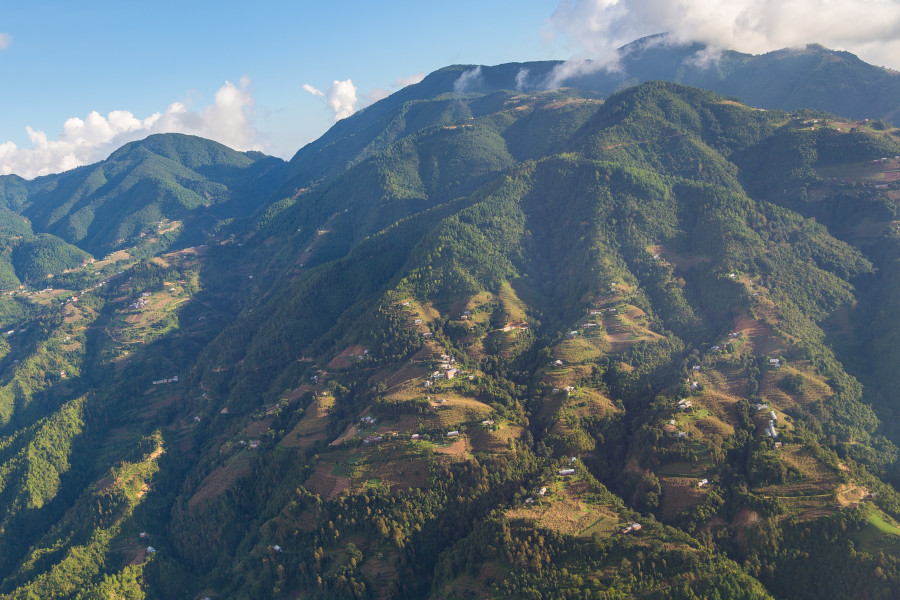Climate & Environment
Dadeldhura, once covered with forests, is gradually losing trees
Up until a decade ago, Dadeldhura was almost all lush forest. Over 75 percent of the district was under a cover of the massive Mahabharat forest, which spread for 66 kilometres from Mahakali in the west to the Tele highlands along the Doti border in the east. The Chure forest spread from Mahakali to Kailali. But today, massive deforestation and encroachment by human settlements have destroyed nearly a half of the forests.
DR Pant
Up until a decade ago, Dadeldhura was almost all lush forest. Over 75 percent of the district was under a cover of the massive Mahabharat forest, which spread for 66 kilometres from Mahakali in the west to the Tele highlands along the Doti border in the east. The Chure forest spread from Mahakali to Kailali. But today, massive deforestation and encroachment by human settlements have cut down the forests by nearly half.
Forests cover 115,000 hectares of the total 153,800 hectares of land in the district. These forests are divided into two distinct areas—the Mahabharat, spread across the mid-hill region, and the Chure forest in the southern part of the district in close proximity to the Tarai, according to the District Forest Office. But a study conducted two months ago by the Sustainable Development Research and Training Centre showed that almost 35 percent of this forest area has been stripped naked.
Entry to the once-dense Mahabharat forest, which runs along the Bhimdutta Highway in western Nepal, shows large swathes of open spaces where trees once stood. To the north-west of district headquarters, deforestation and human settlements have systematically encroached upon the inner forest.
According to the government data, Dadeldhura exports over 200,000 cubic feet of timber every year, but there is no available record on illegal timber business, which many say, is rampant in the district.
Out of the total Chure forest area in the district, 40 percent of the forest coverage has been turned into human settlements by the people who have mostly migrated from the nearby inner Tarai region, according to surveys by various non-government organisations. Almost 50 hectares of forest lands have been encroached upon by illegal settlers.
Various development works are also to blame for the deforestation. Following the formation of local government, road construction throughout the district has led to shrinking forest lands.
“Each local unit is constructing around 200 km of road on average,” said Dilli Raj Joshi, a Dadeldhura native and former central committee member of the Community Forest Consumer Federation. He has long been involved in the conservation of the Mahabharat forest. “Deforestation is taking place at an unprecedented rate, and development works are being carried out without conducting environmental impact assessments,” Dilli Raj said.
The seven local units in Dadeldhura have taken up the task of connecting each unit with roads, which has resulted in the destruction of large swathes of forest lands, he added.
The district forest authorities, however, do not seem to see this deforestation as a problem. “The forest area does not shrink, nor the resources deplete just by cutting down trees,” said Prakash Joshi, assistant district forest officer. “Cutting down old and deceased trees only helps revive the forest.”
For Prakash, human encroachment and livestock grazing inside the forests have bigger impacts on the health of the forest. Those living around the forests exploit resources in an unsustainable manner and need to be made aware of the importance of conservation, he said.
“The forest areas in Dadeldhura can be brought back to their previous state within five years if exploitation of forest resources is put to an end,” said Prakash.
“Encroachment is higher in government-protected forests while deforestation is a growing concern in community forests,” said Tek Raj Pandeya, chairman of the Sustainable Development Research and Training Centre. “Political interference and a lack of legal action are major factors that have led to the unchecked destruction of forests in Nepal.”
The government has declared 2019-20 afforestation year or a ‘year of plantation’ and subsequently, introduced various programmes and policies to conserve forests. According to recent data, over Rs 170 million is being spent annually on conservation programmes related to the Mahabharat and Chure forests, including on the President’s Chure Conservation Programme and Forest Development Programme, along with others introduced by various foreign donor organisations.
There are 485 community forests, 171 leasehold forests, seven sacred forests and three private forests in Dadeldhura. As per regulations, each community forest must allocate 25 percent of the income generated from forest resources, which generally amounts to Rs 500,000 to Rs 700,000, towards conservation works.
However, locals and activists remain sceptical of both governmental and non-governmental programmes.
“Although there are plans in place to save the forests, they remain limited to paper,” said Jayaraj Paneru, coordinator of the Mahabharat Conservation Campaign. “Apart from some government programmes, all other conservation programmes have been ineffective so far.”




 5.55°C Kathmandu
5.55°C Kathmandu










